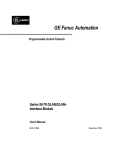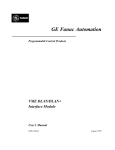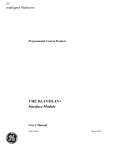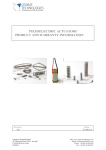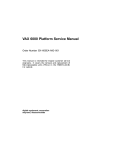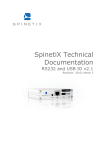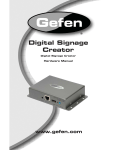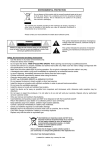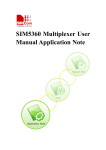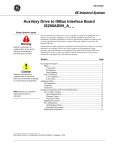Download Series 90-70 DLAN/DLAN+ Interface Module Manual
Transcript
GE Intelligent Platforms ÎÎ Programmable Control Products Series 90* -70 DLAN/DLAN+ Interface Module User’s Manual GFK-0729D March 2010 GFL-002 Warnings, Cautions, and Notes as Used in this Publication Warning Warning notices are used in this publication to emphasize that hazardous voltages, currents, temperatures, or other conditions that could cause personal injury exist in this equipment or may be associated with its use. In situations where inattention could cause either personal injury or damage to equipment, a Warning notice is used. Caution Caution notices are used where equipment might be damaged if care is not taken. Note: Notes merely call attention to information that is especially significant to understanding and operating the equipment. This document is based on information available at the time of its publication. While efforts have been made to be accurate, the information contained herein does not purport to cover all details or variations in hardware or software, nor to provide for every possible contingency in connection with installation, operation, or maintenance. Features may be described herein which are not present in all hardware and software systems. GE Intelligent Platforms assumes no obligation of notice to holders of this document with respect to changes subsequently made. GE Intelligent Platforms makes no representation or warranty, expressed, implied, or statutory with respect to, and assumes no responsibility for the accuracy, completeness, sufficiency, or usefulness of the information contained herein. No warranties of merchantability or fitness for purpose shall apply. * indicates a trademark of GE Intelligent Platforms, Inc. and/or its affiliates. All other trademarks are the property of their respective owners. ©Copyright 2010 GE Intelligent Platforms, Inc. All Rights Reserved Contact Information If you purchased this product through an Authorized Channel Partner, please contact the seller directly. General Contact Information Online technical support and GlobalCare http://www.ge-ip.com/support 1H2 Additional information http://www.ge-ip.com/ 3H Solution Provider [email protected] 4H Technical Support If you have technical problems that cannot be resolved with the information in this guide, please contact us by telephone or email, or on the web at www.ge-ip.com/support 5H Americas Online Technical Support www.ge-ip.com/support 6H7 Phone 1-800-433-2682 International Americas Direct Dial 1-780-420-2010 (if toll free 800 option is unavailable) Technical Support Email [email protected] 8H9 Customer Care Email Primary language of support [email protected] 10H English Europe, the Middle East, and Africa Online Technical Support www.ge-ip.com/support 12H3 Phone +800-1-433-2682 EMEA Direct Dial +352-26-722-780 (if toll free 800 option is unavailable or if dialing from a mobile telephone) Technical Support Email [email protected] 14H5 Customer Care Email Primary languages of support [email protected] 16H7 English, French, German, Italian, Czech, Spanish Asia Pacific Online Technical Support www.ge-ip.com/support Phone 18H9 +86-400-820-8208 +86-21-3217-4826 (India, Indonesia, and Pakistan) Technical Support Email [email protected] (China) 20H1 [email protected] (Japan) 2H3 [email protected] (remaining Asia customers) 24H5 Customer Care Email [email protected] 26H7 [email protected] (China) 28H Preface The Series 90t-70 DLAN/DLAN+ Interface Module, from GE Intelligent Platforms North America, Inc., is a high-performance interface between the GE Drive Systems DLAN and DLAN+ local area network (LAN) protocols and Series 90-70 PLC systems. Revisions to This Manual This version (GFK-0729D) of the Series 90-70 DLAN/DLAN+ Interface Module User’s Manual has added information to Table 3-12, Drop Feedback Registers, in Chapter 3. A description of Register Number 78 has been added, and additional information for Register Number 80 has been added. These changes were implemented in v1.31 DLAN_L and v1.31 DCONFIG. Content of this Manual This manual contains the following chapters: Chapter 1. Introduction: describes the features of the DLAN Interface module. The basic operation of Series 90-70 DLAN applications is also introduced in this chapter. Chapter 2. Installing the DLAN Interface Module: explains how to install and configure the DLAN Interface module in a Series 90-70 PLC system and how to install the companion Logicmaster 90-70 program folder. Chapter 3. The DLAN User Interface: describes the PLC interface to DLAN devices and how to customize it, including the PLC data and Logicmaster 90-70 program. Related DLAN Interface Module Publications For more information, refer to these publications: Important Product Information for Series 90t-70 DLAN/DLAN+ Interface Module (GFK-1048). Data Sheet for the DLAN/DLAN+ Interface module (GFK-0728). Related Series 90 Publications For more information on Series 90 programmable controllers, refer to these publications: Series 90t-70 Programmable Controller Installation Manual (GFK-0262). Logicmastert 90-70 Programming Software User’s Manual (GFK-0263). Series 90t-70 Programmable Controller Reference Manual (GFK-0265). v GFK-0729D Preface We Welcome Your Comments and Suggestions At GE Intelligent Platforms, we strive to produce quality technical documentation. After you have used this manual, please take a few moments to complete and return the Reader’s Comment Card located on the next page. Henry A. Konat Senior Technical Writer vi Series 90t-70 DLAN/DLAN+ Interface Module User’s Manual - March 1996 GFK-0729D Contents Chapter 1 Introduction . . . . . . . . . . . . . . . . . . . . . . . . . . . . . . . . . . . . . . . . . . . . . . . 1-1 Section 1: System Overview . . . . . . . . . . . . . . . . . . . . . . . . . . . . . . . . . 1-1 DLAN Basics . . . . . . . . . . . . . . . . . . . . . . . . . . . . . . . . . . . . . . . . . . . . . . . . . . DLAN Interface Module Functions . . . . . . . . . . . . . . . . . . . . . . . . . . . . . . . . . Series 90-70 DLAN Applications . . . . . . . . . . . . . . . . . . . . . . . . . . . . . . . . . . Section 2: DLAN Interface Module Description . . . . . . . . . . . . . . . . LED Indicators . . . . . . . . . . . . . . . . . . . . . . . . . . . . . . . . . . . . . . . . . . . . . . . . . Restart Pushbutton . . . . . . . . . . . . . . . . . . . . . . . . . . . . . . . . . . . . . . . . . . . . . . Battery . . . . . . . . . . . . . . . . . . . . . . . . . . . . . . . . . . . . . . . . . . . . . . . . . . . . . . . DLAN Network Connector . . . . . . . . . . . . . . . . . . . . . . . . . . . . . . . . . . . . . . . DLAN Configuration Jumpers . . . . . . . . . . . . . . . . . . . . . . . . . . . . . . . . . . . . . 25-Pin Connectors . . . . . . . . . . . . . . . . . . . . . . . . . . . . . . . . . . . . . . . . . . . . . . Chapter 2 1-3 1-4 1-4 1-4 1-5 1-5 1-6 Installing the DLAN Interface Module . . . . . . . . . . . . . . . . . . . . . . . . . 2-1 What You Will Need . . . . . . . . . . . . . . . . . . . . . . . . . . . . . . . . . . . . . . . . . . . . 2-2 Overview . . . . . . . . . . . . . . . . . . . . . . . . . . . . . . . . . . . . . . . . . . . . . . . . . . . . . . Installing a Series 90-70 DLAN Interface Module . . . . . . . . . . . . . . . . . . . . . Section 2: DLAN Jumper Configuration . . . . . . . . . . . . . . . . . . . . . . . DLAN Configuration Jumpers . . . . . . . . . . . . . . . . . . . . . . . . . . . . . . . . . . . . . Selecting the Network Type . . . . . . . . . . . . . . . . . . . . . . . . . . . . . . . . . . . . . . . Selecting RS-485 Termination Resistors . . . . . . . . . . . . . . . . . . . . . . . . . . . . . Section 3: Configuring a DLAN Interface Module . . . . . . . . . . . . . . I/O Configuration Rack Screen . . . . . . . . . . . . . . . . . . . . . . . . . . . . . . . . . . . . Adding a DLAN Interface Module to the Rack Screen . . . . . . . . . . . . . . . . . . Section 4: Installing the GE_DLAN Logicmaster Folder . . . . . . . . . 2-3 2-3 2-4 2-5 2-5 2-6 2-6 2-8 2-8 2-9 2-11 Installing the Folder . . . . . . . . . . . . . . . . . . . . . . . . . . . . . . . . . . . . . . . . . . . . . 2-11 The DLAN User Interface . . . . . . . . . . . . . . . . . . . . . . . . . . . . . . . . . . . . 3-1 Section 1: Overview 3-2 The DLAN Interface Program . . . . . . . . . . . . . . . . . . . . . . . . . . . . . . . . . . . . . Signals . . . . . . . . . . . . . . . . . . . . . . . . . . . . . . . . . . . . . . . . . . . . . . . . . . . . . . . . Section 2: Data Allocation and Configuration . . . . . . . . . . . . . . . . . Limitations On Use Of Discrete Temporary References . . . . . . . . . . . . . . . . . User Configuration . . . . . . . . . . . . . . . . . . . . . . . . . . . . . . . . . . . . . . . . . . . . . . Global Data . . . . . . . . . . . . . . . . . . . . . . . . . . . . . . . . . . . . . . . . . . . . . . . . . . . . GFK-0729C 1-3 Section 3: Configuring the DLAN Interface module . . . . . . . . . . . . Section 1: Installing the DLAN Interface Module Hardware . . . . . Chapter 3 1-1 1-2 1-2 Series 90t-70 DLAN/DLAN+ Interface Module User’s Manual - November 1995 3-2 3-3 3-5 3-5 3-5 3-7 vii Contents Section 3: Using the DLAN Interface Program . . . . . . . . . . . . . . . . . GFK-0729C 3-17 What the GE_DLAN Program Provides . . . . . . . . . . . . . . . . . . . . . . . . . . . . . 3-17 Adding Application-Specific Logic To the GE_DLAN Program . . . . . . . . . . 3-17 GE_DLAN Program Structure . . . . . . . . . . . . . . . . . . . . . . . . . . . . . . . . . . . . . 3-17 Adding a DLAN Application Block . . . . . . . . . . . . . . . . . . . . . . . . . . . . . . . . . 3-18 What the DLAN Application Block Needs to Do . . . . . . . . . . . . . . . . . . . . . . 3-19 Series 90t-70 DLAN/DLAN+ Interface Module User’s Manual - November 1995 viii Contents Table 1-1. MODULE OK LED Status . . . . . . . . . . . . . . . . . . . . . . . . . . . . . . . . . . . . . . . . . . . . . . . . . . . . . . . 1-4 Table 2-1. Jumper Positions For Selecting DLAN Network Type . . . . . . . . . . . . . . . . . . . . . . . . . . . . . . . . . 2-6 Table 2-2. Jumper Positions For RS-485 Network Termination Resistors . . . . . . . . . . . . . . . . . . . . . . . . . . . 2-7 Table 3-1. User Configuration Data . . . . . . . . . . . . . . . . . . . . . . . . . . . . . . . . . . . . . . . . . . . . . . . . . . . . . . . . . 3-6 Table 3-2. PLC Global Data . . . . . . . . . . . . . . . . . . . . . . . . . . . . . . . . . . . . . . . . . . . . . . . . . . . . . . . . . . . . . . . 3-7 Table 3-3. Broadcast Command Bits . . . . . . . . . . . . . . . . . . . . . . . . . . . . . . . . . . . . . . . . . . . . . . . . . . . . . . . . 3-8 Table 3-4. Drop Command Bits . . . . . . . . . . . . . . . . . . . . . . . . . . . . . . . . . . . . . . . . . . . . . . . . . . . . . . . . . . . . 3-8 Table 3-5. Broadcast Setpoints . . . . . . . . . . . . . . . . . . . . . . . . . . . . . . . . . . . . . . . . . . . . . . . . . . . . . . . . . . . . . 3-10 Table 3-6. Drop Setpoints . . . . . . . . . . . . . . . . . . . . . . . . . . . . . . . . . . . . . . . . . . . . . . . . . . . . . . . . . . . . . . . . . 3-10 Table 3-7. Status Registers . . . . . . . . . . . . . . . . . . . . . . . . . . . . . . . . . . . . . . . . . . . . . . . . . . . . . . . . . . . . . . . . 3-11 Table 3-8. Link Presence Bits . . . . . . . . . . . . . . . . . . . . . . . . . . . . . . . . . . . . . . . . . . . . . . . . . . . . . . . . . . . . . . 3-12 Table 3-9. Diagnostic Registers . . . . . . . . . . . . . . . . . . . . . . . . . . . . . . . . . . . . . . . . . . . . . . . . . . . . . . . . . . . . 3-12 Table 3-10. Page Presence Bits . . . . . . . . . . . . . . . . . . . . . . . . . . . . . . . . . . . . . . . . . . . . . . . . . . . . . . . . . . . . 3-13 Table 3-11. Broadcast Feedback Registers . . . . . . . . . . . . . . . . . . . . . . . . . . . . . . . . . . . . . . . . . . . . . . . . . . . . 3-13 Table 3-12. Drop Feedback Registers . . . . . . . . . . . . . . . . . . . . . . . . . . . . . . . . . . . . . . . . . . . . . . . . . . . . . . . 3-14 GFK-0729C Series 90t-70 DLAN/DLAN+ Interface Module User’s Manual - November 1995 ix Contents Figure 1-1. Series 90-70 DLAN/DLAN+ Interface Module . . . . . . . . . . . . . . . . . . . . . . . . . . . . . . . . . . . . . . 1-3 Figure 2-1. Series 90-70 DLAN Interface Module Configurations . . . . . . . . . . . . . . . . . . . . . . . . . . . . . . . . . 2-3 Figure 2-2. Detail of DLAN Configuration Jumpers From Figure 1-1. . . . . . . . . . . . . . . . . . . . . . . . . . . . . . 2-5 Figure 2-3. Selecting a DLAN Configuration Jumper Position . . . . . . . . . . . . . . . . . . . . . . . . . . . . . . . . . . . . 2-6 Figure 3-1. GE_DLAN Interface Program Structure . . . . . . . . . . . . . . . . . . . . . . . . . . . . . . . . . . . . . . . . . . . . 3-17 Figure 3-2. GE_DLAN MAIN Program Flow . . . . . . . . . . . . . . . . . . . . . . . . . . . . . . . . . . . . . . . . . . . . . . . . . 3-18 Figure 3-3. Program Flow . . . . . . . . . . . . . . . . . . . . . . . . . . . . . . . . . . . . . . . . . . . . . . . . . . . . . . . . . . . . . . . . 3-19 GFK-0729C Series 90t-70 DLAN/DLAN+ Interface Module User’s Manual - November 1995 x restart lowapp ARestart oddapp: ARestarts for autonumbers that do not restart in each chapter. figure bi level 1, reset table_big level 1, reset chap_big level 1, reset1 Lowapp Alwbox restart evenap:A1app_big level 1, resetA figure_ap level 1, reset table_ap level 1, reset figure level 1, reset table level 1, reset these restarts oddbox reset: 1evenbox reset: 1must be in the header frame of chapter 1. a:ebx, l 1 resetA a:obx:l 1, resetA a:bigbx level 1 resetA a:ftr level 1 resetA c:ebx, l 1 reset1 c:obx:l 1, reset1 c:bigbx level 1 reset1 c:ftr level 1 reset1 Reminders for autonumbers that need to be restarted manually (first instance will always be 4) let_in level 1: A. B. C. letter level 1:A.B.C. num level 1: 1. 2. 3. num_in level 1: 1. 2. 3. rom_in level 1: I. II. III. roman level 1: I. II. III. steps level 1: 1. 2. 3. Chapter 1 Introduction 1 Section 1: System Overview The Series 90t-70 DLAN/DLAN+ Interface Module (catalog number IC697BEM763), from GE Intelligent Platforms, 32 North America, Inc., is a high-performance interface between the GE Drive Systems DLAN and DLAN+ local area network (LAN) protocols and Series 90t-70 PLC systems. It permits DC300, AC2000, and DC2000 drives to be controlled from Series 90-70 PLC application programs. In this manual, the module will usually be referred to simply as the DLAN Interface module. The reader should keep in mind that it supports both GE Drive Systems network protocols. DLAN Basics GE Drive systems devices communicate using one (or both, in some cases) of two types of network protocol: H DLAN, a multidrop serial protocol - sometimes referred to as DLAN– or old DLAN. H DLAN+, a high speed protocol based on Arcnet Information is shared on the network using data pages. A page is a collection of 16 bit data words. Each device (or drop) is allocated one or more pages. Each page can contain up to 256 words and is partitioned into blocks of 16 words each. DLAN supports 32 pages per network, and DLAN+ supports 255 pages per network. The information within a page (its data structure) depends on the device and is often referred to as a dialect. Devices with multiple pages can use a different dialect for each page. Each device is responsible for periodically detecting changes in its page(s) of information and then broadcasting any changes on the network. This is the mechanism used by controllers, such as the DLAN Interface module, to maintain an up-to-date copy of the data in other network devices. Controllers issue commands to other devices on the network by sending messages. Command messages can be directed to a specific target device or broadcast, and can contain one new data item for the device’s data page(s). DLAN Interface Module Functions The Series 90-70 DLAN Interface module can operate as either a DLAN or DLAN+ controller. However, a single module can not be both a DLAN and DLAN+ controller at the same time. If GFK-0729D 1-1 1 an application requires both DLAN and DLAN+ devices, two DLAN Interface modules must be used. The module passes page data and commands between network devices and a PLC application program. The knowledge about what the network devices are intended to do is contained in the PLC program. Series 90-70 DLAN Applications Hardware Requirements The minimum hardware configuration for a Series 90-70 DLAN or DLAN+ application requires these components: 1. A Series 90-70 rack and power supply. 2. A Series 90-70 PLC CPU module to run the application program. CPU firmware version 5.00 or later is required. 3. One or more Series 90-70 DLAN Interface modules installed in another slot or slots. 4. A DLAN or DLAN+ network connected to each DLAN Interface module. 5. One or more GE Drive Systems devices connected to each network. Typically, additional Series 90-70 modules will also be required to monitor and control the application. However, the discussion in this manual is limited to the DLAN Interface module and the associated PLC program. 1-2 Series 90t-70 DLAN/DLAN+ Interface Module User’s Manual - March 1996 GFK-0729D 1 Section 2: DLAN Interface Module Description LED Indicators The three LED indicators, shown in the following figures, are mounted along the top front edge of the DLAN Interface module. a47027 DOOR Î Î MODULE OK COMMAND OUT DATA IN RESTART ÎÎ ÎÎ BEM 763 MODULE OK COMMAND OUT DATA IN ON = OK, ACTIVE OTHER LEDS FOR FACTORY USE. PUSH TO RESTART COMMUNICATION. DLAN CONNECTOR DLAN NETWORK CONNECTOR TXATXA+ TXBTXB+ 5V 0V TX RX 1 2 3 4 5 6 7 8 (D CONNECTORS NOT USED) DLAN CONFIGURATION JUMPERS MODULE FUNCTION GE DRIVES DLAN INTERFACE MODULE: IC697BEM763 LABEL: 44A726758-139R02 Figure 1-1. Series 90-70 DLAN/DLAN+ Interface Module MODULE OK LED The MODULE OK LED indicates the current status of the DLAN Interface module. It has three states: GFK-0729D Chapter 1 Introduction 1-3 1 Table 1-1. MODULE OK LED Status State OFF Description When the MODULE OK LED is off, the DLAN Interface module is not functioning. This is the result of a hardware malfunction; for example, the diagnostic checks detected a failure, or the PLC CPU is not present. Corrective action is required in order to get the module functioning again. When the LED is on steadily, the DLAN Interface module is functioning properly. Normally, this LED should always be on, indicating that the diagnostic tests were successfully completed and the Logicmaster 90-70 configuration data for the module is correct. ON Flashing The LED flashes during power-up diagnostics. Note The DLAN Interface module has a hardware watchdog timer that is periodically reset by the module software. If the watchdog timer expires, the module stops functioning and the MODULE OK LED turns off. COMMAND OUT LED The center LED indicator, referred to as COMMAND OUT on the module door label, has two functions. It flashes on briefly during the self test that occurs when the PLC is powered on or the module Restart pushbutton is pressed. During normal operation, it flashes whenever a command from the PLC application program is sent to a network drop. DATA IN LED The lower LED indicator, referred to as DATA IN on the module door label, flashes whenever a page data update message is received from one of the network drops. Most frequently, these messages contain feedback data. If none of the drops broadcasts an update message, this LED will flash every two seconds as long as any active drops are connected to the network. Restart Pushbutton Pressing the Restart pushbutton on the DLAN Interface module for any length of time will halt DLAN communication and cause the module to perform its internal tests. If the module is used with the GE_DLAN PLC program furnished with the module (or an application derived from it), communication will restart automatically. Battery The DLAN Interface module does not use a battery. DLAN Network Connector This eight-pin connector provides the connections from the DLAN Interface module to the DLAN or DLAN+ network.. A connector on the cable from the DLAN network connection block mates to the connector on the module. 1-4 Series 90t-70 DLAN/DLAN+ Interface Module User’s Manual - March 1996 GFK-0729D 1 DLAN Configuration Jumpers These jumpers are used to configure the network connection when the Network Type is specified as DLAN. JP2 through JP4 are used to select either the optically isolated LAN network or an RS-485 LAN network. If the RS-485 LAN network is selected, JP5 and JP6 are used to select whether the RS-485 network termination resistors are IN or OUT. 25-Pin Connectors The two DB-25S connectors on the DLAN Interface module are not used. GFK-0729D Chapter 1 Introduction 1-5 1 Section 3: Configuring the DLAN Interface module Before a DLAN Interface module can be used in a Series 90-70 PLC system, it must be configured using the Logicmastert 90-70 Configuration software. This topic is covered in detail in chapter 2 of this manual. 1-6 Series 90t-70 DLAN/DLAN+ Interface Module User’s Manual - March 1996 GFK-0729D Chapter 1 1 Installing the DLAN Interface Module section level 1 1 figure bi level 1 table_big level 1 This chapter explains how to install a DLAN Interface module in a Series 90-70 PLC system and how to install the necessary software. There are several easy steps in preparing the DLAN Interface module for use. This chapter is divided into four sections. The necessary equipment and software packages required for the installation process are described on the following page. After that, each section describes one step of the installation procedure in detail. Step 1. Installing the DLAN Interface Module Hardware: Refer to section 1 for the first step in the installation procedure. Section 1 describes the physical installation of the DLAN Interface module in a Series 90-70 rack. Hardware descriptions are also included. Step 2. DLAN Jumper Configuration: Section 2 describes how to set the DLAN configuration jumpers located on the DLAN daughter board when the Network Type is specified as DLAN. Step 3. Configuring the DLAN Interface Module: Section 3 contains the second step in the installation procedure. It describes how to add a DLAN Interface module to the Series 90-70 I/O configuration, using Logicmaster 90-70 configuration software. Step 4. Installing the DLAN Interface Module Software: Section 4 describes how to install DLAN Interface PLC software on a programming computer. GFK-0729D 1-1 1 What You Will Need Before you can begin the installation procedure, you must have the following equipment and software: 1-2 A Series 90-70 programmable controller (PLC) system. The PLC CPU must have version 5.00 or later firmware. One or more DLAN Interface modules (catalog number IC697BEM763). An MS-DOS based computer with a hard disk and MS-DOS version 3.0 or later. The computer can be: A Workmaster An IBM PC-XT, PC-AT, PS/2 or compatible personal computer with an 83-key or 101-key keyboard. A Workmaster keyboard. II industrial computer. or CIMSTAR I industrial computer with an 83-key or 101-key Logicmaster 90-70 configuration and programming software, version 5.01 or later. The DLAN Interface software that is provided with the DLAN module.. MS-DOS is a registered trademark of Microsoft Corporation IBM is a registered trademark of International Business Machines Corporation Series 90-70 DLAN/DLAN+ Interface Module User’s Manual - March 1996 GFK-0729D 1 Section 1: Installing the DLAN Interface Module Hardware The first step in the installation procedure is to physically install the DLAN Interface module hardware and verify that it is working properly. Overview In a single rack system, DLAN Interface modules reside in the same rack as the PLC CPU. In a multiple rack Series 90-70 PLC, DLAN Interface modules can reside in either the CPU rack or expansion racks. The following illustration shows two possible system configurations for installing a Series 90-70 DLAN Interface module in either a local or expansion rack. ÎÎ Î ÎÎ ÎÎ ÎÎ Î ÎÎ ÎÎ ÎÎ Î ÎÎ Î ÎÎ ÎÎ ÎÎ Î ÎÎ ÎÎ ÎÎ Î Î ÎÎ Î ÎÎ ÎÎ ÎÎ Î ÎÎ ÎÎ ÎÎ Î Î ÎÎ ÎÎ ÎÎ Î ÎÎ ÎÎ ÎÎ Î Î ÎÎ ÎÎ Î ÎÎ ÎÎ ÎÎ Î ÎÎ ÎÎ ÎÎ Î ÎÎ Î ÎÎ ÎÎ ÎÎ Î ÎÎ ÎÎ ÎÎ Î ÎÎ ÎÎÎ ÎÎ ÎÎÎÎ ÎÎÎÎÎ Î ÎÎ ÎÎ ÎÎ ÎÎ Î ÎÎ ÎÎ ÎÎ Î ÎÎ ÎÎ ÎÎ ÎÎ ÎÎ Î ÎÎ ÎÎ Î ÎÎ ÎÎ ÎÎ ÎÎ ÎÎ ÎÎ Î ÎÎ ÎÎ ÎÎ Î ÎÎ ÎÎ ÎÎ ÎÎ ÎÎ Î ÎÎ ÎÎ Î ÎÎ ÎÎ ÎÎÎ ÎÎÎ ÎÎ ÎÎ ÎÎ Î ÎÎ ÎÎ ÎÎ Î ÎÎ ÎÎ ÎÎ ÎÎ Î ÎÎ ÎÎ Î ÎÎ ÎÎ ÎÎ ÎÎ ÎÎ ÎÎ Î ÎÎ ÎÎ ÎÎ Î ÎÎ ÎÎ ÎÎ ÎÎ ÎÎ Î ÎÎ ÎÎ Î ÎÎ ÎÎ ÎÎ ÎÎ ÎÎ ÎÎ Î ÎÎ ÎÎ ÎÎ Î ÎÎ ÎÎ ÎÎ ÎÎ ÎÎ Î ÎÎ ÎÎ Î ÎÎ ÎÎ ÎÎ ÎÎ ÎÎ ÎÎ ÎÎÎÎÎ ÎÎ Î ÎÎ ÎÎÎÎ ÎÎÎ ÎÎ ÎÎÎÎ ÎÎÎ ÎÎ LOCAL RACK CONFIGURATION P S C D P L U A N CPU RACK P S a47028 EXPANSION RACK C B P T U M P S B D R L M A N Figure 1-1. Series 90-70 DLAN Interface Module Configurations The power supply, CPU, and Series 90-70 Bus Transmitter (BTM) or Bus Receiver Module (BRM) must reside in specific slots within each rack. The CPU module must be located in slot 1 of rack 0. When a Series 90-70 system includes a Bus Transmitter Module (BTM), it can be located in any slot as long as it is not to the right of an empty slot. If the PLC system has more than one rack, a Bus Receiver Module (BRM) must be located in slot 1 of each expansion rack. Note Version A of the Bus Transmitter Module must be installed to the right of all other GE modules. There must be no empty slots between the Bus Transmitter Module and the CPU module. GFK-0729D Chapter 2 Installing the DLAN Interface Module 1-3 1 DLAN Interface modules can be placed in any unused slot in any rack, provided that these conditions are met: The configuration created by Logicmaster 90-70 configuration software must match the physical configuration of the modules. If it does not, the PLC can not operate as expected. Configuration faults are logged in the PLC fault table. Refer to the Logicmaster 90-70 Programming Software User’s Manual, GFK-0263, for more information on PLC configuration using Logicmaster 90-70 software. The DLAN Interface module(s) must be configured correctly in the Logicmaster 90-70 configuration. If not, the DLAN Interface module(s) will not operate. See section 2 of this chapter for information on configuring the module. All the slots between the DLAN Interface module(s) and the PLC CPU (in the CPU rack) or the Bus Receiver Module (in an expansion rack) must be occupied. If any of these slots are empty, the DLAN Interface module(s) cannot communicate across the backplane to the PLC CPU or Bus Receiver Module. Installing a Series 90-70 DLAN Interface Module To install a Series 90-70 DLAN Interface module, follow these steps: 1-4 1. Set the CPU Run/Stop switch to STOP. This prevents the PLC program from initiating any command that can affect the operation of the module. 2. Power off the Series 90-70 PLC system. 3. Locate the desired rack and slot. 4. Remove the Series 90-70 DLAN Interface module from the shipping carton, but leave it in its anti-static plastic bag. Touch an exposed metal surface of the PLC rack to discharge any electrostatic charge you may have picked up. Then remove the DLAN Interface module from the protective bag. 5. Slide the DLAN Interface module completely into the slot. The three LEDs are located at the top of the module. 6. Press the module firmly against the front rails of the PLC rack, but do not use excessive force. When the module is fully seated, you will hear and/or feel clicks from the latches on the top and bottom of the module faceplate. 7. Mount the DLAN/DLAN+ network connection block to the Series 90-70 PLC rack where the DLAN Interface module is installed. Connect the ground wire from the connection block securely to one of the ground studs on the PLC rack. Connect the cable from the connection block to the DLAN Interface module by mating its connector with the DLAN NETWORK CONNECTOR shown in figure 1-1. Finally, connect the network cable or cables to the connection block. If the DLAN Interface module is at one end of the network cable, the appropriate network terminator must be connected at the connection block. 8. Power on the PLC rack. The MODULE OK LED of the DLAN Interface module should immediately begin to flash, and then stay on when diagnostics tests have completed. Series 90-70 DLAN/DLAN+ Interface Module User’s Manual - March 1996 GFK-0729D 1 Section 2: DLAN Jumper Configuration DLAN Configuration Jumpers When the Network Type specified by user configuration data (See Chapter 3, section 2) is DLAN, jumpers on the DLAN daughter board must be used to configure the network connection. This section describes how to set the jumpers. If you are using a DLAN+ network, skip this section. Figure 2-2 is an enlarged view of the DLAN configuration jumpers shown in Figure 1-1. Jumper JP6 is nearest the DLAN network connector. The positions of these jumpers configure the DLAN module connections to a DLAN network. a47078 JP6 JP5 JP4 JP3 JP2 Figure 1-2. Detail of DLAN Configuration Jumpers From Figure 1-1. Figure 2-3 shows the two possible positions for jumpers JP2 through JP6. All of the jumpers are installed in the 1-2 position at the factory. If you need to change one or more jumper positions, use this procedure. Each jumper has a thin tab that extends beyond the edge of the DLAN daughter board toward the front of the module. Grip the tab with needle nose pliers and pull it forward until it is free. Then move the jumper so that it will engage pins 2 and 3, and push it onto the pins. Repeat for each jumper that needs to be changed. GFK-0729D Chapter 2 Installing the DLAN Interface Module 1-5 1 a47079 Pin 3 Pin 3 Pin 2 Pin 2 Pin 1 Pin 1 Jumper shown in 1-2 position. Jumper shown in 2-3 position. Figure 1-3. Selecting a DLAN Configuration Jumper Position Selecting the Network Type In addition to DLAN+, two types of DLAN networks are supported by version 1.04 and later versions of the DLAN Module: optically isolated and RS-485. The DLAN network type is selected by setting jumpers JP2, JP3, and JP4, as shown in Table 2-1. At the factory, these jumpers are set to select the optically isolated network. Table 1-1. Jumper Positions For Selecting DLAN Network Type Jumper Optically Isolated LAN RS-485 LAN JP2 1–2 2–3 JP3 1–2 2–3 JP4 1–2 2–3 Caution If the DLAN module is powered on while connected to an optically isolated network and jumpers JP2, JP3, and JP4 are set to the 2–3 position, the external isolated power supply for the isolated network will be damaged. Selecting RS-485 Termination Resistors If the RS-485 network is selected, the drop at each end of the network cable should have the termination resistors IN. This is true for all drop types, both DLAN modules and drives. Adding additional termination resistors will improve the signal to noise ratio of RS-485 networks, but more than five sets of termination resistors will overload the drivers. Accordingly, no more than five drops on a network should have the termination resistors IN. 1-6 Series 90-70 DLAN/DLAN+ Interface Module User’s Manual - March 1996 GFK-0729D 1 Table 2-2 shows the jumper settings for termination resistors. At the factory, these jumpers are set for termination resistors IN. Table 1-2. Jumper Positions For RS-485 Network Termination Resistors Termination Resistors Jumper IN OUT JP5 1–2 2–3 JP6 1–2 2–3 If the optically isolated network is selected, the termination resistors are not used, and the JP5 and JP6 jumper settings are ignored. GFK-0729D Chapter 2 Installing the DLAN Interface Module 1-7 1 Section 3: Configuring a DLAN Interface Module The second step in the DLAN Interface module installation procedure is to add a DLAN Interface module to the Series 90-70 I/O configuration, using Logicmaster 90-70 configuration software. The configuration software is used to describe all the modules present in the PLC racks. Rack and slot location and other features for individual modules are specified by completing setup screens that represent the modules in a rack. Editing features make it easy to copy, move, replace, or delete module configurations. After completing the Logicmaster 90-70 configuration, you must store it to the PLC where your DLAN Interface module is installed. The configuration has no effect until it is stored to the PLC. The Logicmaster 90-70 status line must display CONFIG EQUAL after the configuration is stored to the PLC. I/O Configuration Rack Screen From the main menu of the Logicmaster 90-70 configuration software, press the I/O soft key (F1). A screen representing the modules in a rack is displayed. The current module on a Series 90-70 I/O Configuration rack screen is highlighted in reverse video. Upon entering the rack screen, the Power Supply module is shown in reverse video. Use the left and right cursor keys to move from module to module. Use the up and down cursor keys to move between racks in descending or ascending order, respectively. The rack screen presents an overview perspective of one Series 90-70 PLC rack. CONFIG VALID is displayed in the lower right corner of each display screen after the configuration is successfully validated. When CONFIG INVALID is indicated, the configuration can not be stored to the PLC. A CONFIG INVALID status is most likely to occur when: 1-8 Series 90-70 DLAN/DLAN+ Interface Module User’s Manual - March 1996 GFK-0729D 1 A slot in a Series 90-70 rack to the left of a module that generates interrupts, such as the DLAN Interface module, is vacant. Input reference addresses (%I and %AI) assigned to two input modules overlap. Bus Transmitter and/or Receiver Modules in a multi-rack Series 90-70 PLC are missing. A Series 90-70 Version A BTM module is not located to the right of all other modules. Adding a DLAN Interface Module to the Rack Screen 1. GFK-0729D With the selected slot location highlighted, press other (F8) and then dlan (F3) from the I/O Rack Configuration screen. Chapter 2 Installing the DLAN Interface Module 1-9 1 1-10 2. Press the Enter key to select the catalog number shown in reverse video and display the DLAN Interface Module detail screen. 3. There are no configurable options for the DLAN Interface module. Press the Esc key to accept it as the module for the current slot. The screen showing all the modules in the rack, now including the DLAN Interface module, will reappear. 4. Press Esc again to save the new configuration and return to the main menu. 5. Press utility (F9), store (F2), and then Enter to store the new configuration to the PLC. The Logicmaster 90-70 status line should now display CONFIG EQUAL. Series 90-70 DLAN/DLAN+ Interface Module User’s Manual - March 1996 GFK-0729D 1 Section 4: Installing the GE_DLAN Logicmaster Folder In order to use the DLAN Interface module, you must create a PLC ladder program to monitor the operation of DLAN or DLAN+ devices and send commands to them. A ladder program that is provided with the module contains the interface between PLC data and the module. This section describes how to install the Logicmaster 90-70 folder that contains this program on your personal computer. Installing the Folder Two software distribution diskettes, one 5.25-inch and one 3.5-inch, are included with the DLAN Interface module. Choose a diskette that fits any diskette drive in your computer. Then follow these steps. 1. Slide the selected diskette into an appropriate diskette drive in your computer. 2. Set your computer’s current disk drive to the floppy drive where you inserted the distribution diskette. If your diskette is in drive A, type a: followed by the Enter key. 3. Run the installation program by typing install followed by the Enter key. 4. The INSTALL program will display a default drive and path for the GE_DLAN folder, usually C:\GE_DLAN. You can change the drive letter to any hard drive or network drive in your computer. You can also change the file path where the GE_DLAN folder will be installed to any valid path. If the path you specify contains subdirectories that do not exist, the INSTALL program will create them. You can install two or more GE_DLAN folders on the same drive by choosing different paths. The INSTALL program does not have the capability to change the GE_DLAN folder name. Accordingly, the program will not permit you to modify the folder name where it appears in the path specification. If your computer does not have a hard drive or network drive, the INSTALL program will display an error message and exit. 5. When you confirm a path for the folder, the INSTALL program will create the new folder and copy these files into it: CPUCFG.CFG DCONFIG.EXP DCONFIG.PDT DCONFIG.STE DLAN_C.PDT DLAN_L.EXP DLAN_L.PDT DLAN_L.STE DLAN_L.XRF IOCFG.CFG LMFOLDER.70 PRINT.XOV _MAIN.DEC _MAIN.LH1 _MAIN.PDT _MAIN.STE _MAIN.XRF This completes the software installation for the DLAN or DLAN+ Interface. GFK-0729D Chapter 2 Installing the DLAN Interface Module 1-11 Chapter 1 1 The DLAN User Interface section level 1 1 figure bi level 1 table_big level 1 This chapter describes the PLC interface to DLAN devices and how to configure it. This chapter contains the following sections: Section 1. Overview: summarizes the PLC data and program logic that comprise the user interface to DLAN devices. Section 2. Data Allocation and Configuration: describes the PLC data used by DLAN applications. Section 3. Using the DLAN Interface Program: A DLAN interface program for Logicmaster 90-70 is provided as a part of the DLAN/DLAN+ Interface Module product. GFK-0729D 1-1 3 Section 1: Overview This section summarizes the PLC data and program logic that comprise the user interface to DLAN devices. Other sections in this chapter describe each of these topics in detail. The DLAN Interface Program The DLAN/DLAN+ Interface Module product includes a distribution diskette that contains a Series 90-70 PLC program folder. This program provides a bit and data mapped interface to a DLAN/DLAN+ network. Interface Rules The interface supports drives only and is subject to the following rules: 1. Network drop number assignments must begin at one (1) and continue sequentially. 2. On DLAN+ networks, the page number for each drop must equal the drop number. 3. On DLAN networks, the expected acks and weighted zero options must be selected for all drives. 4. All drives will receive the same command set and must send the same feedback data. Program Components The program contains these parts: H A MAIN program. H A DLAN_L program block. H A DCONFIG program block. H A DLAN_C external block. These components are summarized in the following paragraphs. For a detailed discussion of the program and information on adapting it for your application, see section 3 of this chapter. The MAIN Program The MAIN program version in the distribution diskette contains only a CALL to the DLAN_L block. This version is a starting point for your application. You will need to add program logic that uses the data described in section 2 of this chapter. The DLAN_L block The DLAN_L block is called by MAIN once during each PLC execution sweep. It contains program logic for initializing DLAN data; for configuring the DLAN Interface module; for updating status data, diagnostic data, and feedback signals; and for sending DLAN command messages. DLAN_L contains local register (%L) data used for configuration of your application. This data is initialized by the DATA_INIT_DLANA function block in DLAN_L. You will probably need to change some of the values specified in this function block. 1-2 Series 90t-70 DLAN/DLAN+ Interface Module User’s Manual - March 1996 GFK-0729D 3 See User Configuration in section 2 of this chapter for information on configuring DLAN global data. The DCONFIG block The DCONFIG block is called as necessary by DLAN_L to configure the DLAN Interface module. This configuration process is transparent to the user application. All the logic needed to configure the module is provided for you in the DLAN_L program block. The DLAN_C External Block The DLAN_C block is responsible for communication between the PLC CPU and the DLAN Interface module(s). Signals Series 90-70 PLC applications for DLAN and DLAN+ devices use PLC data and program logic as the interface to these devices. This interface is based on the concept of signals. A DLAN signal is an item of data that is sent either from the PLC program to a data page of a DLAN or DLAN+ device, or from a data page in the device to the PLC program. Signals contain at least 16 bits of data. Four kinds of signals are used. 1. Command bits 2. Setpoint data 3. Feedback data 4. Link presence bits These signal types are summarized in the following paragraphs. Command Bits The PLC program sends DLAN commands by setting one or more discrete data points. An action list is predefined for each command bit. Action lists consist of individual LAN commands in a generic list structure. Each command bit is preconfigured to send one or more commands to one or more DLAN drops. During each PLC program sweep, all command bits are compared their previous values. When one or more changes are detected, the commands that correspond to each changed bit are sent to the DLAN Interface module for transmission on the network. Setpoints In the PLC, a setpoint consists of a data word and a corresponding setpoint bit. Each setpoint bit is preconfigured for a particular drop and page location within that drop. To issue a new setpoint, the PLC program first updates the setpoint value and sets the corresponding setpoint bit. During the program sweep, all the setpoint bits are also checked. When a setpoint bit is detected, the corresponding value is sent to the DLAN Interface module for transmission on the network, and the setpoint bit is cleared. LAN Update of Setpoints There are actually two copies of setpoint data in the PLC: GFK-0729D Chapter 3 The DLAN User Interface 1-3 3 1. A value in the user setpoint table that can be changed by the PLC program. 2. The corresponding location in the feedback data array for the target DLAN drop. This copy is written by the DLAN interface program; it may be read by MAIN and other program blocks. When the user changes a setpoint value and then sets the command bit to send it, the target drive updates its corresponding page location after it receives the command. A short time later, the drive echoes the new value back to the DLAN feedback data array. In anticipation of the new value from the drop, the DLAN_L program block updates the setpoint in the feedback array with the new value. This provides a convenient mechanism for the user’s PLC logic to determine when to set a particular setpoint bit. Whenever the setpoint value and the corresponding feedback value are different, the setpoint value needs to be sent to the drop. The user logic can accomplish this by setting the appropriate setpoint bit. Note that a temporary interruption of communication between the DLAN Interface module and the drop could occur after the DLAN feedback array was updated but before the drop actually changed its data page. In this case, the interruption would cause a discrepancy between the DLAN feedback array and the data page in the drop. When communication is restored, the current value from the drop’s data page will be copied to the feedback array. If the user program now compares the setpoint to the corresponding feedback value, the difference will be detected, and the appropriate setpoint bit can be set in order to update the page data in the drop. Feedback Signals Feedback data is copied to a PLC global (%R) memory block (specified in the DLAN_L block user configuration data) as it arrives from DLAN drops. The user program may examine this data at any time. Link Presence Signals Periodically, all devices on the LAN network report their presence. The DLAN Interface program keeps a record of this information in link presence bits. These bits, along with the LAN status and diagnostic information, are copied to a PLC global memory block specified by the user. 1-4 Series 90t-70 DLAN/DLAN+ Interface Module User’s Manual - March 1996 GFK-0729D 3 Section 2: Data Allocation and Configuration This section describes the PLC data used by DLAN applications. Caution Some of the data used by the DLAN interface program is global, such as Discrete Internal (%M) and Register (%R). The application designer must be certain that data references in other parts of the application do not conflict with references assigned to the DLAN interface. The DLAN_L program block uses Register %R00001 and preserves its contents. The only restriction on its use by other parts of the PLC program is that it must never be modified by an interrupt block. The DLAN_L program block also uses Discrete Temporary (%T) references. These references may be used in other program blocks, but are subject to the limitations described below. Failure to observe this caution will result in unexpected and potentially unsafe operation. Limitations On Use Of Discrete Temporary References Temporary references that are used by the DLAN_L block are subject to these limitations when used in other program blocks: 1. They must never be modified by an interrupt block. 2. The DLAN_L program block modifies the states of discrete temporary (%T) points. Consequently, the program must never rely on the state of %T points that are set before it calls the DLAN_L block to be correct after the call unless the MAIN program saves the %T table before the DLAN_L call and restores the table after the call. 3. Transitional %T contacts must not be relied on because the DLAN_L block affects them in complex ways. User Configuration Values are assigned to user configuration data in a Series 90-70 PLC DATA_INIT function block in DLAN_L. This data specifies certain information about each DLAN Interface module used by the application: GFK-0729D 1. The rack and slot location of the DLAN Interface module. 2. Whether a DLAN or DLAN+ network will be used. 3. The network address of the DLAN Interface module. 4. The total number of network drops, including the DLAN Interface module, connected to the network. Chapter 3 The DLAN User Interface 1-5 3 5. The update rate for feedback signals. 6. The starting PLC memory offsets for DLAN signal tables. Default values are provided in the DLAN_L program block. You can change these defaults, as appropriate for your application, by using Logicmaster 90-70 programming software to zoom into the DATA_INIT_DLANA block in DLAN_L. The following table describes each item of user configuration data. Table 1-1. User Configuration Data Range Description DLAN DLAN+ Default PLC CONFIGURATION Rack number of DLAN interface module 0–7 0 Slot number of DLAN interface module 2–9 2 Start address of Command bits (%M) Varies with CPU model. 1 Start address of Setpoint bits (%M) Varies with CPU model. 305 Start address of Setpoint registers (%R) Varies with CPU config. 3 Start address of Status and Diagnostic registers (%R) Varies with CPU config. 101 DLAN CONFIGURATION Network type Group assignment of this DLAN interface module 0 1 1 30 0–255 30 Drop number of this DLAN interface module 1–31 1–255 250 Total number of drops on this DLAN 2–32 Don’t care 32 Feedback update rate (.01 sec) 3–32 3–32 32 Number of class A drives 1–31 1–48 1 Entering the User Configuration To change the user configuration values, enter the Program Display/Edit display of the Logicmaster 90-70 programming software by typing the progrm soft key (F1) at the main menu. Move the cursor to the DLAN_L program block and press the zoom soft key (F10). The user configuration data is initialized by the DATA_INIT_DLANA function block in RUNG 4. Move the cursor to the DATA_INIT_DLANA function block and press the zoom soft key (F10) again. You will see a screen that is similar to Table 3-1. The rack number and slot number values in this display must be changed to match the rack and slot location where the DLAN Interface module was installed in the PLC. The number of class A drives value must match the number of drives attached to the network. If a DLAN (not DLAN+) network will be used, the network type and drop number values must also be changed appropriately. 1-6 Series 90t-70 DLAN/DLAN+ Interface Module User’s Manual - March 1996 GFK-0729D 3 Caution The start addresses for setpoint bits, setpoint registers, and status and diagnostic registers must be modified in accordance with the number of class A drives on the network so that the four global data tables do not overlap. The default start addresses are based on seven (7) drives. See table 3-2, below, for information needed to calculate start addresses for a different number of drives. Global Data The User Configuration contains four (4) parameters specifying the starting addresses of global data tables used by the DLAN interface. You must allocate the PLC global data specified by each of these parameters when planning your PLC program. This table shows the global data table sizes that must be allocated. Table 1-2. PLC Global Data Table Name Default Start Location Data Size Command Bit Table %M00001 16 points + (number of class A drives * 36) Setpoint Bit Table %M00305 8 points + (number of class A drives * 12) Setpoint Value Table %R00003 8 registers + (number of class A drives * 12) Status and Diagnostics Table %R00101 50 registers Feedback Table %R00151[ 1–16 class A drives: 17–32 class A drives: 33–48 class A drives: 554 1108 1662 [ The feedback table start location is not configurable. It always begins 50 registers after the start of the status and diagnostics table. Caution The PLC global data tables specified in user configuration data must not be used for any other purpose in the application. Because these tables are specified indirectly, Logicmaster 90-70 is not aware of them and will not warn you about conflicts. The Logicmaster 90-70 SEARCH and HIGHEST REFERENCE USED functions are also unaware of these tables. When developing your application, you must be absolutely certain that these tables do not overlap data references used by other parts of the application. Use caution when increasing the number of class A drives. Command Bit Table Format The format of the command bits is defined in the following tables. The Bit Number value for each table entry is relative to the start address of the command bit table. For example, the default address of the Qstp bit is %M00002. GFK-0729D Chapter 3 The DLAN User Interface 1-7 3 Broadcast bits: The first 16 command bits are reserved for broadcast commands. Table 1-3. Broadcast Command Bits Bit Number Command Name Pickup Action Dropout action 1 Normal Stop Issues a normal stop command to all drives; also clears Run Fwd/Rev None 2 Qstp Issues a quick stop command to all drives None 3 Cstp Issues a coast stop command to all drives None 4 SoftReset Issues a soft reset command to all drives None 5 Jog Fwd Brings all drives to the Fwd Jog state Stop jog 6 Jog Rev Brings all drives to the Rev Jog state Stop jog 7 Run Fwd Brings all drives to the Run0 Fwd state Stop 8 Run Rev Brings all drives to the Run0 Rev state Stop 9 - 16 Reserved Drop command bits: The next 36 bits are defined for drop 1 commands, followed by 36 bits for drop 2, etc. The total number of command bits is (16 broadcast bits + (36 times the number of drives on the network)). Table 1-4. Drop Command Bits Bit Number Command Name Pickup Action Dropout action 17 Normal Stop Issues a normal stop command to drop 1; also clears Run Fwd/ Rev None 18 Qstp Issues a quick stop command to drop 1 None 19 Cstp Issues a coast stop command to drop 1 None 20 SoftReset Issues a soft reset command to drop 1 None 21 Draw Req Issues a transfer to Draw Speed Regulator None 22 Cur Req Issues a transfer to Current Regulator Issues a transfer to Draw Speed Regulator 23 Proc Req Issues a transfer to Process Regulator Issues a transfer to Draw Speed Regulator 24 Jog Fwd Brings drop 1 to the Fwd Jog state Stop jog 25 Jog Rev Brings drop 1 to the Rev Jog state Stop jog 26 Run Fwd Brings drop 1 to the Run0 Fwd state Stop Table 3-4. Drop Command Bits (continued) 1-8 Series 90t-70 DLAN/DLAN+ Interface Module User’s Manual - March 1996 GFK-0729D 3 Bit Number Command Name Pickup Action Dropout action 27 Run Rev Brings drop 1 to the Run0 Rev state Stop 28 Slow Sets up drop 1 for Slow Removes slow command 29 Run1 Sets up run reference for run1 Removes Run1 30 Run2 Sets up run reference for run2 Removes Run2 31 Refr Inh Inhibits drop 1 reference register Removes reference inhibit 32 Mot1 Motor 1 request Removes motor 1 command 33 Mot2 Motor 2 request Removes motor 2 command 34 Hold Diam Issues hold diameter mode Removes hold diameter 35 Rcal Ilimit Selects recalibrate current limit mode Removes recalibrate current limit 36 Auto Ref Selects auto reference Removes auto reference select 37 Lup_out 01 Sets physical output 1 on LUP card Resets physical output 1 on LUP card 38 Lup_out 02 Sets physical output 2 on LUP card Resets physical output 2 on LUP card 39 Lup_out 03 Sets physical output 3 on LUP card Resets physical output 3 on LUP card 40 Lup_out 04 Sets physical output 4 on LUP card Resets physical output 4 on LUP card 41 Lup_out 05 Sets physical output 5 on LUP card Resets physical output 5 on LUP card 42 Lup_out 06 Sets physical output 6 on LUP card Resets physical output 6 on LUP card 43 Lup_out 07 Sets physical output 7 on LUP card Resets physical output 7 on LUP card 44 Reserved 45 Auxcmd 16 Sets Auxcmd 16 Resets Auxcmd 16 46 Auxcmd 17 Sets Auxcmd 17 Resets Auxcmd 17 47 Auxcmd 18 Sets Auxcmd 18 Resets Auxcmd 18 48 Auxcmd 19 Sets Auxcmd 19 Resets Auxcmd 19 49 Slak_tk_up Issues Slack take up Removes Slack take up 50 Slak_tk_dn Issues Slack take down Removes Slack take down 51 - 52 Reserved 53 - 88 Drop 2 command bits 89 - 124 Drop 3 command bits, etc. Setpoint Bit and Register Table Formats The start addresses for setpoint bits and setpoint registers that are specified in the DATA_INIT_DLANA function block in DLAN_L define the beginning references for these tables. Each setpoint bit corresponds to a setpoint register. A setpoint change is commanded by storing the new value in the setpoint register and then setting the corresponding setpoint bit. The GFK-0729D Chapter 3 The DLAN User Interface 1-9 3 setpoint bit is reset by the DLAN interface when the command is issued. The setpoint bits/registers are defined as follows: Broadcast setpoints: The first 8 setpoints are reserved for broadcast commands. The Bit/Setpoint Number value for each table entry is relative to the setpoint bit start address for setpoint bits and relative to the setpoint register start address for setpoint registers. For example, the default address of the MMS_SETPT bit is %M00305, and the default address of the MMS_SETPT register is %R00003. Table 1-5. Broadcast Setpoints Bit/Setpoint Number Mnemonic Description 1 MMS_SETPT MMS speed setpoint 2 SPEED_SETPT Speed setpoint 3-8 Reserved Drop command setpoints: The next 12 setpoints are reserved for drop one (1) commands, followed by 12 setpoints for each additional drop. The total number of setpoint bits/registers is (8 broadcast setpoints + (12 times the number of drives on the network)). Table 1-6. Drop Setpoints Bit/Setpoint Number 1-10 Mnemonic Description 9 MMS_SETPT MMS speed setpoint 10 SPEED_SETPT Speed setpoint 11 IRATIO_SETPT Iratio setpoint 12 PROCESS_SETPT Process setpoint 13 GAGE_SETPT Winder gauge preset 14 WIDTH_PRESET Winder width preset 15 TENRF_SETPT Tension reference 16 PRESET_DIAM Winder preset diameter 17 DRAWSETP Draw Setpoint 18 - 20 Reserved 21 - 32 Drop 2 bits/setpoints 33 - 44 Drop 3 bits/setpoints, etc. Series 90t-70 DLAN/DLAN+ Interface Module User’s Manual - March 1996 GFK-0729D 3 Status, Diagnostics and Feedback Table Format The start address for status and diagnostic registers that is specified in the DATA_INIT_DLAN A function block in DLAN_L defines the beginning of these tables. The first 50 registers are reserved for status and diagnostic information. They are followed by the feedback variables for each drop, as shown in the following tables. The Register Number value for each table entry is relative to the start address of the table. For example, the default address of LAN_STATUS_1 is %R00101. Table 1-7. Status Registers Register Number 1 2 3 4 GFK-0729D Mnemonic Description LAN_STATUS_1 BIT 1 - READY 2 - RUN 3 - ENABLED 4 - Q_FULL 5 - 16 Status Bits: LAN_STATUS_2 BIT 1 - 16 Status Bits: LAN_ERROR_1 BIT 1 - INVCC 2 - NLCFG 3 - UDDIAL 4 - NSCFG 5 - INVIP 6-7 8 - MDIALE Power up diagnostics complete DLAN card configuration complete DLAN card communicating on the network Network command queue full Reserved Reserved Configuration errors: Invalid configuration command No LAN configuration Undefined dialect Invalid configuration Invalid internal page Reserved Maximum number of dialects exceeded 9 - SMIF 10 - UADPR 11 - ICDB 12 - DBFI 13 - SRAM Initialization errors: Shared memory interface failure Unable to allocate dual port RAM Incorrect daughter board Daughter board failed to initialize Daughter board shared RAM failure 14 - 16 Reserved LAN_ERROR_2 BIT 1 - INVLC 2 - DBWD 3 - HOSTWD 4 - IPUPDF 5 - INVIM 6-8 9 - 16 Run time errors: Invalid LAN command Daughter board watchdog timeout Host watchdog timeout Internal page update failure Invalid internal page marker Reserved Reserved 5 UPDATE_CTR Feedback update counter 6 FAILED_2_ACK Last drop number that failed to acknowledge 7 DYNGRPA Dynamic group membership (16 - 01) 8 DYNGRPB Dynamic group membership (32 - 17) 9 Reserved 10 LUV_VUP_FAULT Chapter 3 The DLAN User Interface DLAN card fault code 1-11 3 Link Presence Bits: The bits in these registers are set to one when the corresponding drop is present on the network. Table 1-8. Link Presence Bits Register Number Bit Numbers Corresponding Drops 11 16 - 1 Drops 15 - 12 16 - 1 Drops 31 - 16 0 13 16 - 1 Drops 47 - 32 14 16 - 1 Drops 63 - 48 15 16 - 1 Drops 79 - 64 16 16 - 1 Drops 95 - 80 17 16 - 1 Drops 111 - 96 18 16 - 1 Drops 127 - 112 19 16 - 1 Drops 143 - 128 20 16 - 1 Drops 159 - 144 21 16 - 1 Drops 175 - 160 22 16 - 1 Drops 191 - 176 23 16 - 1 Drops 207 - 192 24 16 - 1 Drops 223 - 208 25 16 - 1 Drops 239 - 224 26 16 - 1 Drops 255 - 240 Diagnostics Registers: The INV_CMND_NUM, UNDEF_SIGNAL, and INV_SIGNAL registers contain non-zero values only when the corresponding error bits in LAN_ERROR_1 or LAN_ERROR_2 are set. Table 1-9. Diagnostic Registers Register Number 1-12 Mnemonic Description 27 INV_CMND_NUM Invalid command number - zero unless bit 1 of LAN_ERROR_1 or bit 1 of LAN_ERROR_2 is set. 28 UNDEF_SIGNAL Undefined signal number (invalid dialect) - zero unless bit 3 of LAN_ERROR_1 is set. 29 INV_SIGNAL Invalid signal number (invalid internal page) - zero unless bit 5 of LAN_ERROR_1 is set. 30 NUM_SIGNALS Number of signals configured - always valid. Series 90t-70 DLAN/DLAN+ Interface Module User’s Manual - March 1996 GFK-0729D 3 Page Presence Bits: Each bit in these registers is set to one when data in the corresponding page is present on the network (applies to Arcnet only). Table 1-10. Page Presence Bits Register Number Bit Numbers Corresponding Pages 31 16 - 1 Pages 15 - 32 16 - 1 Pages 31 - 16 0 33 16 - 1 Pages 47 - 32 34 16 - 1 Pages 63 - 48 35 16 - 1 Pages 79 - 64 36 16 - 1 Pages 95 - 80 37 16 - 1 Pages 111 - 96 38 16 - 1 Pages 127 - 112 39 16 - 1 Pages 143 - 128 40 16 - 1 Pages 159 - 144 41 16 - 1 Pages 175 - 160 42 16 - 1 Pages 191 - 176 43 16 - 1 Pages 207 - 192 44 16 - 1 Pages 223 - 208 45 16 - 1 Pages 239 - 224 46 16 - 1 Pages 255 - 240 47 - 50 Reserved Broadcast Feedback Variables: The first 10 feedback variables are reserved for broadcast commands. By default, the address of ACTION_0 is %R00151. Table 1-11. Broadcast Feedback Registers Register Number GFK-0729D Mnemonic Description 51 ACTION_0 52 RUP_IN_0 53 MMS_SETPT MMS speed setpoint 54 SPEED_SETPT Speed setpoint 55 - 60 Reserved Chapter 3 The DLAN User Interface 1-13 3 Drop Feedback Variables: The broadcast feedback variables are followed by 34 feedback variables for each drop. The total number of status and feedback registers is 50 status + 10 broadcast + (34 times the number of drives on the network)). Table 1-12. Drop Feedback Registers Register Number Description 61 ACTION_0 Reserved 62 RUP_IN_0 Bit 1- 2 3 4 5 6 7 8 9 10 - 12 13 14 15 16 Command status: RUP_IN_1 Bit 1- 6 7 8 - 10 11 12 - 16 Command status LUP_OUT Bit 1 2 3 4 5 6 7 8 - 16 LUP output status AUXCMD Bit 1 2 3 4 5 - 16 Auxcmd status ACTION_1 Bit 1-6 7 8 9 - 16 Command Status 67 MMS_SETPT MMS speed setpoint 68 SPEED_SETPT Speed setpoint 63 64 65 66 1-14 Mnemonic Reserved Drive run command Reverse command Slow command Reserved Run 1 commanded Run 2 commanded Reference inhibit commanded Reserved Motor 1 commanded Motor 2 commanded Diameter hold active Reserved Reserved Recalibrate current limit commanded Reserved Auto reference selected Reserved LUP output 1 LUP output 2 LUP output 3 LUP output 4 LUP output 5 LUP output 6 LUP output 7 Reserved Auxcmd 16 Auxcmd 17 Auxcmd 18 Auxcmd 19 Reserved Reserved Slack take up commanded Slack take down commanded Reserved Series 90t-70 DLAN/DLAN+ Interface Module User’s Manual - March 1996 GFK-0729D 3 Table 3-12. Drop Feedback Registers (continued) Register Number Description 69 IRATIO_SETPT Iratio setpoint 70 PROCESS_SETPT Process setpoint 71 GAGE_SETPT Gauge setpoint 72 WIDTH_PRESET Width preset 73 TENRF_SETPT Tension reference 74 PRESET_DIAM Preset diameter 75 DRAWSETP Draw setpoint 76 - 77 Reserved 78 AUXFBK16_31 Bit 1 2 3 4 5 6 7 8 9 10 11 12 13 14 15 16 Aux fbk status COMB_BITS Bit 1 2 3 4 5- 6 7 8 9 10 11 12 13 14 15 - 16 Drive status 79 GFK-0729D Mnemonic Chapter 3 The DLAN User Interface Aux fbk bit 16 Aux fbk bit 17 Aux fbk bit 18 Aux fbk bit 19 Aux fbk bit 20 Aux fbk bit 21 Aux fbk bit 22 Aux fbk bit 23 Aux fbk bit 24 Aux fbk bit 25 Aux fbk bit 26 Aux fbk bit 27 Aux fbk bit 28 Aux fbk bit 29 Aux fbk bit 30 Aux fbk bit 31 Run fwd active Run rev active Jog fwd active Jog rev active Reserved Slow fwd active Slow rev active Stop active Maint locked Speed active Draw active Current active Process active Reserved 1-15 3 Table 3-12. Drop Feedback Registers (continued) Register Number 80 81 1-16 Mnemonic RUP_OUT_0 Bit 1 2 3 4 5 6 7 8 9 10 11 12 - 16 Description Drive status No fault (1 = nofault) Trip fault (1 = fault) or winning speed run active jog active ma closed reserved preconditioned reference enabled running zero speed reserved LUP_IN Bit 1 2 3 4 5 6 7 8 9 10 11 12 13 14 15 - 16 LUP in 01 status LUP in 02 status LUP in 03 status LUP in 04 status LUP in 05 status LUP in 06 status LUP in 07 status LUP in 08 status LUP in 09 status LUP in 10 status LUP in 11 status LUP in 12 status LUP in 13 status LUP in 14 status Reserved 82 FAULT Drive fault code 83 LCPSFB Speed feedback 84 FDIAMFDB Diameter feedback 85 VFB Voltage feedback 86 LCPCFB Current feedback 87 FLDFB Field current feedback 88 POSFDBK Position Feedback 89 - 94 Reserved 95 - 128 Drop 2 feedback variables 129 - 162 Drop 3 feedback variables, etc. Series 90t-70 DLAN/DLAN+ Interface Module User’s Manual - March 1996 GFK-0729D 3 Section 3: Using the DLAN Interface Program A DLAN interface program for Logicmaster 90-70 is provided as a part of the DLAN/DLAN+ Interface Module product. See The DLAN Interface Program in section 1 of this chapter for an overview of the program. What the GE_DLAN Program Provides The interface program is installed in a Logicmaster 90-70 folder named GE_DLAN. The MAIN program in GE_DLAN is not a complete DLAN application. It contains only the interface logic that will enable a PLC application program to monitor and control DLAN drives. Other logic must be added to make use of the interface. Adding Application-Specific Logic To the GE_DLAN Program There are two ways to use the GE_DLAN folder: 1. You can create a new folder and copy the contents of the GE_DLAN folder to it. Then, you can add new logic for your application to the program that was copied. 2. You can add the interface logic in the GE_DLAN folder to an existing application in another folder. To do this, first export the DLAN_L, DCONFIG, and DLAN_C blocks from GE_DLAN to a Logicmaster 90-70 library. Then import these blocks into the other folder. Finally, add a CALL to DLAN_L to the existing application at a location that will assure that DLAN_L is called once per program sweep. See the Logicmastert 90-70 Programming Software User’s Manual, GFK-0263, for information on these procedures. GE_DLAN Program Structure GE_DLAN contains a MAIN program plus blocks named DLAN_L, DCONFIG, and DLAN_C. Figure 3-1 shows the block calling structure of the GE_DLAN program. MAIN DCONFIG DLAN_L DLAN_C Figure 1-1. GE_DLAN Interface Program Structure GFK-0729D Chapter 3 The DLAN User Interface 1-17 3 The MAIN Program Figure 3-2 shows the trivial logic sequence of the MAIN program of GE_DLAN. Call DLAN_L MAIN Figure 1-2. GE_DLAN MAIN Program Flow The DLAN_L Program Block DLAN_L is called once from the MAIN program during every PLC sweep. Each time it is called, DLAN_L performs this sequence of operations: 1. If necessary, initialize DLAN_L data and the DLAN module. 2. Update global status data. 3. Update global feedback data. 4. Configure DLAN module. 5. Service commands The DLAN_C External Block DLAN_C performs all the command processing and communication functions of the interface. It is implemented in the C programming language to make it fast and efficient. Adding a DLAN Application Block To make a working DLAN application, other processing steps must be added. The details of these additional steps will vary, depending on your application. The preferred method of adding these processing steps is to put them into a program block of their own. The application block must be called once each PLC sweep either from MAIN or another program block. Figure 3-3 shows how to add a block named USR_APP to MAIN. Additional program logic may also be added to MAIN, if necessary. 1-18 Series 90t-70 DLAN/DLAN+ Interface Module User’s Manual - March 1996 GFK-0729D 3 Call USR_APP Call DLAN_L ( Additional processing if desired ) MAIN Figure 1-3. Program Flow What the DLAN Application Block Needs to Do Every DLAN application block needs to carry out at least these steps: 1. Evaluate network status 2. Evaluate feedback data 3. Set command bits 4. Assign setpoint data These steps are described in the following sections. Evaluate Network Status Link presence bits and Network diagnostics status values should be checked on every program sweep. Safety requirements for your application may require specific actions based on these values. Evaluate Feedback Data Feedback data values from DLAN drives should also be checked on each sweep. These values often determine what commands and setpoint changes will need to be made on the next sweep. Set Command Bits In this step, appropriate commands are enabled by setting the corresponding bits in the Command Bit Table. The choice of appropriate commands and the conditions that should enable them will depend on the specific requirements of your application. Assign Setpoint Data In this processing step, the Setpoint Value Table is updated with new setpoint values, and the corresponding bits in the Setpoint Bit Table are set. Other setpoint bits may also need to be set to correct discrepancies between the Setpoint Value Table and the corresponding setpoint values in the Feedback Table. GFK-0729D Chapter 3 The DLAN User Interface 1-19 Index A I/O configuration rack screen, 2-8 with Logicmaster 90-70 software, 2-8 Adding a DLAN application block, 3-18 Connector, DLAN network, 1-4 Adding a DLAN interface to the rack screen, 2-9 Connectors, 25-pin (not used), 1-5 Controllers, 1-1 Allocation and configuration, 3-5 Application block assigns setpoint data, 3-19 evaluates feedback data, 3-19 evaluates LAN status, 3-19 sets command bits, 3-19 D Data allocation and configuration, 3-5 DATA IN LED, 1-4 Application block, adding, 3-18 Data pages, 1-1 Applications, DLAN, 1-2 Data, global, 3-7 Arcnet, 1-1 Data, user configuration, 3-6 Assign setpoint data, 3-19 Diagnostic registers, 3-12 Dialect, 1-1 B Basics, DLAN, 1-1 Diskette, distribution, 2-11 Battery, 1-4 Distribution diskette, 2-11 Bits, page presence, 3-13 DLAN, 1-1 application, hardware requirements, 1-2 applications, 1-2, 3-5 basics, 1-1 configuration, 1-6 interface module functions, 1-2 module description, 1-3 Block application, 3-18 DLAN_C external, 3-18 DLAN_L program, 3-18 Broadcast command bits, 3-8 Broadcast feedback registers, 3-13 Bus receiver module (BRM), 2-3 Bus transmitter module (BTM), 2-3 C Command bit table format, 3-7 broadcast bits, 3-8 drop command bits, 3-8 Command bits, set, 3-19 COMMAND OUT LED, 1-4 Configuration data, user, 3-6 DLAN application block adding, 3-18 assign setpoint data, 3-19 evaluate feedback data, 3-19 evaluate LAN status, 3-19 set command bits, 3-19 DLAN Configuration Jumpers, 1-5 DLAN interface program interface rules, 3-2 program components, 3-2 DCONFIG block, 3Ć3 DLAN_C external block, 3Ć3 DLAN_L block, 3Ć2 MAIN program, 3Ć2 using, 3-17 Configuration, user, 3-5 DLAN jumper configuration, 2-5 Configuring DLAN jumpers, 2-5 DLAN module battery, 1-4 COMMAND OUT LED, 1-4 configuration jumpers, 1-5, 2-5 Configuring the DLAN module, 1-6 adding a DLAN module to the rack screen, 2-9 GFK-0729C Discrete temporary references, limitations, 3-5 Index-1 Index DATA IN LED, 1-4 LED indicators, 1-3 network connector, 1-4 OK LED, 1-3 watchdog timer, 1-4 DLAN network connector, 1-4 DLAN+, 1-1 DLAN_C external block, 3-18 Drop command bits, 3-8 Drop command setpoints, 3-10 Drop feedback registers, 3-14 E Evaluate feedback data, 3-19 Evaluate LAN status, 3-19 External block, DLAN_C, 3-18 F Feedback data, evaluate, 3-19 DLAN configuration jumpers, 1-5 DLAN module description, 1-3 DLAN network connector, 1-4 installing other modules, 2-3 installing the DLAN hardwaree, 2-3 LED indicators, 1-3 OK LED, 1-3 steps for installation, 2-4 watchdog timer, 1-4 what you will need, 2-2 Hardware requirements, 1-2 I I/O configuration rack screen, 2-8 Installing the DLAN interface, 2-1 configuring with Logicmaster 90-70 software, 2-8 creating a PLC ladder diagram, 2-11 installing other modules, 2-3 installing the DLAN hardware, 2-3 installing the folder, 2-11 steps for installation, 2-4 what you will need, 2-2 Interface module functions, 1-2 Folders, Logicmaster 90-70, 2-11 Functions, DLAN interface module, 1-2 G J Jumper configuration, DLAN, 2-5 Jumpers, DLAN configuration, 1-5 GE Drive Systems, 1-1 GE_DLAN interface program adding application specific logic, 3-17 contents of, 3-17 program structure DLAN_C external block, 3Ć18 DLAN_L program block, 3Ć18 MAIN program, 3Ć17 Global data, 3-7 command bit table format, 3-7 setpoint bit, 3-10 L LAN status, evaluate, 3-19 LED indicators, 1-3 on Series 90-70 DLAN, 1-3 Limitations for discrete temporary references, 3-5 Link presence bits, 3-12 Local area network, 1-1 H Hardware battery, 1-4 COMMAND OUT LED, 1-4 DATA IN LED, 1-4 Index-2 Logicmaster 90-70 software, 2-8 adding a DLAN interface to the rack screen, 2-9 DLAN2 folder, 2-11 GE_DLAN folder, 2-11 I/O configuration rack screen, 2-8 NEWDLAN folder, 2-11 GFK-0729C Index M Registers, broadcast feedback, 3-13 Registers, drop feedback, 3-14 Module description COMMAND OUT LED, 1-4 DATA IN LED, 1-4 DLAN configuration jumpers, 1-5 LED indicators, 1-3 network connector, 1-4 OK LED, 1-3 restart pushbutton, 1-4 watchdog timer, 1-4 Restart pushbutton, 1-4 RS-485 termination resistors, 2-6 S Selecting network type, 2-6 Selecting RS-485 termination resistors, 2-6 Module functions, 1-2 Set command bits, 3-19 Module hardware, restart pushbutton, 1-4 Setpoint bits and registers, 3-10 broadcast, 3-10 drop commands, 3-10 Monitor operation of DLAN devices, 2-11 N Network connector, DLAN, 1-4 Network type, selecting, 2-6 O OK LED, 1-3 Operation of DLAN devices, monitoring of, 2-11 Other modules, installing, 2-3 Overview, system, 1-1 P Page presence bits, 3-13 Setpoint data, assign, 3-19 Setpoints broadcast, 3-10 drop command, 3-10 Signals command bits, 3-3 feedback, 3-4 link presence, 3-4 setpoints, 3-3 Status and diagnostic registers, 3-11 broadcast feedback variables, 3-13 diagnostic registers, 3-12 drop feedback variables, 3-14, 3-15, 3-16 link presence bits, 3-12 page presence bits, 3-13 status registers, table of, 3-11 Status registers, 3-11 System overview, 1-1 Pages, data, 1-1 PLC data, description of, 3-5 PLC global data, 3-7 T Transitional contacts, 3-5 Program block, DLAN_L, 3-18 Protocol high speed, 1-1 multidrop serial, 1-1 Pushbutton, restart, 1-4 R Rack screen, 2-8 Register table, 3-10 GFK-0729C U User configuration changing values, 3-6 entering, 3-6 User configuration data, 3-5 network address of module, 3-5 network type (DLAN or DLAN+), 3-5 number of network drops, 3-6 rack and slot location, 3-5 Index-3 Index starting PLC memory offsets, 3-6 table, 3-6 update rate for feedback signals, 3-6 V Variables broadcast feedback, 3-13 Index-4 drop feedback, 3-14 W Watchdog timer, 1-4 GFK-0729C


















































